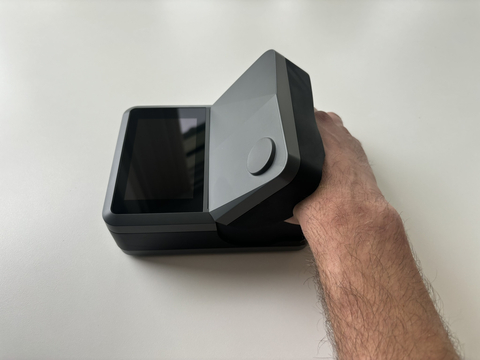Algorithm transfer is a key prerequisite for the development of a commercial wearable non-invasive glucose monitor for universal use
- Study based on the participation of 50 people with type 2 diabetes
- Results showed clinical accuracy of new device, not previously used for monitoring, that had been programmed with RSP Systems' algorithm
- RSP's device also enabled the reduction in the pre-calibration period from several weeks to c.4 hours
- Study conducted by RSP Systems, the Institute for Diabetes Technology, the University of Ulm, Dr Guido Freckmann and Eva Zschornack, and Professor K.D. Hepp
RSP Systems (RSP), the company developing the world's first universal non-invasive glucose monitoring wearable, has had the results of a key study published by Nature Scientific Reports (Nature) demonstrating successful pre-trained calibration and continual non-invasive glucose monitoring in patients with type 2 diabetes using RSP's GlucoBeam Smart technology.
This press release features multimedia. View the full release here: https://www.businesswire.com/news/home/20250410015734/en/

RSP Systems' GlucoBeam Smart device used in the Nature study
The study, entitled "Calibration and performance of a Raman-based device for non-invasive glucose monitoring in type 2 diabetes", involved 50 people with type 2 diabetes over a two day period. The patients were intentionally diverse with respect to age, BMI, duration of diabetes, HbA1c, and form of therapy to cover a wide spectrum for testing the performance of the device.
Patients were monitored using RSP's GlucoBeam Smart technology which measures skin glucose using light only. The reflected light was analyzed to establish levels of glucose. The recorded data was compared to traditional blood sample testing via a finger prick test and showed that it was comparable with respect to numerical and clinical accuracy.
The key part of the study was the calibration step for each individual via direct electronic model transfer. Previous studies have required a significant level of pre-testing calibration, in some cases for several weeks. In this study, comparable results were achieved with a calibration period of less than 4 hours. To date, achieving this level of information transfer has been a major obstacle to industrial standardization, production and commercial scalability.
Dr. Guido Freckmann, Medical Director CEO of the Institute for Diabetes Technology (IfDT), Ulm, and one of the co-authors of the Nature study said:"The published study had a robust design and showed promising accuracy results for the prototype. The use of a further developed device with optimized calibration algorithms in patients' everyday lives has thus become more likely."
Anders Weber, CEO of RSP Systems, added: "The publication of this data based on our GlucoBeam technology in such a prestigious publication as Nature is an important step for us. We have demonstrated in previous studies that GlucoBeam delivers pain-free, real-time glucose measurements without piercing the skin, testing it in over >800 patients in clinical and home settings. Today's published data in Nature not only demonstrates our Raman-based technology has the ability to provide continuous, accurate monitoring but that it can do so with significantly reduced and practical pre-calibration. We are now working on the miniaturization of our technology prior to commercialization.
He added, "This method of algorithm transfer is the final milestone in our strategy to create and commercialize the world's first wearable non-invasive glucose monitor for universal use."
According to the International Diabetes Federation, approximately 540 million adults worldwide live with the metabolic disease, diabetes, half of whom have not yet been diagnosed. By 2030, the number of people affected is expected to rise to 643 million and by 2045 to 783 million. Diabetes and its co-morbidities have cost c.$966 billion in health care expenditures. If the disease is not treated or is treated incorrectly, there is a risk of secondary diseases such as blindness, kidney failure or heart attack, according to the WHO.
Find out more about RSP HERE and follow our LinkedIn community at RSP Systems for updates on non-invasive glucose monitoring.
Notes to editors
About RSP Systems
RSP Systems is developing the first non-invasive glucose monitoring wearable for people needing to monitor their blood-sugar levels. Its proprietary technology, GlucoBeam Smart, is based on near-infrared Raman spectroscopy and proprietary mathematical modelling to deliver accurate, on-the-go results. RSP's Touch Glucose Monitoring (TGM) technology has been tested in over 800 patients in clinical and home settings, and more than 250,000 datapoints have been collected. RSP Systems has partnered with Trumpf Photonics, a global leader in VCSEL laser technology, on miniaturization to create a wearable form. The Company is preparing for market clearance in the US prior to commercialisation.
About Raman Spectroscopy
Near-infrared Raman spectroscopy is considered as one of the most promising technologies for non-invasive glucose monitoring. Specific advantages include insensitivity to water and the ability to detect glucose in the interstitial space between cells and blood vessels in the skin layer. To date, to achieve a strong enough Raman signal has required complex instrumentation, however with the rapid development in light sources, the market potential of miniaturized Raman systems is becoming a reality.
View source version on businesswire.com: https://www.businesswire.com/news/home/20250410015734/en/
Contacts:
For more information, please contact:
RSP Systems
Anders Weber, CEO of RSP Systems
Tel: +45 7199 2818
Vigo Consulting (Media)
Melanie Toyne-Sewell Rozi Morris
Tel: +44 20 7390 0230
/ +44 7890 022 814
